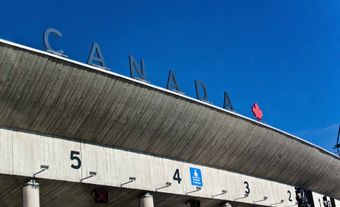The term “irregular immigration” has no clear legal definition. (See also Immigration to Canada.) An irregular immigrant can refer to an individual crossing a country’s border without proper authority. It can also apply to those who violate residency conditions after entering a country. Many irregular immigrants come to Canada to seek asylum and apply for refugee status. (See Refugees to Canada; Canadian Refugee Policy.) With no reliable published statistics in Canada, estimates of this cohort range from 200,000 to 400,000. The majority of these individuals likely live in Toronto and other large urban centres.
See also Immigration Policy in Canada; Canada–United States Safe Third Country Agreement.
Canadian Immigration Status Categories
The federal government mainly controls who gets to come to and stay in Canada. Canadian law divides all people into three categories. The first two categories are “Canadian citizens” and “permanent residents of Canada,” who can travel in and out of the country relatively easily. The third category is “foreign nationals,” who do not have citizenship or permanent residency. Canada uses a visa system to temporarily allow or deny entry to foreign nationals.
Those without citizenship (“non-citizens”) can be subject to deportation and have their status revoked by the Canadian government. (See also Immigration Detention in Canada.) “Non-citizens” include temporary (usually foreign nationals) and permanent residents. Also included are migrant workers (see Canada’s Temporary Foreign Worker Programs), asylum seekers and other people with semi-permanent status. Only Canadian citizens truly have a legal right to stay permanently in Canada.
Irregular Immigration
Most, if not all, irregular immigration to Canada concerns non-citizens and their families. We can distinguish between irregular entry and irregular stay in Canada. An individual may enter a country without documentation and be considered an irregular entrant. That individual can later apply for or acquire “regularization” — official legal status in Canada. Conversely, an immigrant may enter a country through regular means, such as a preauthorized visa, but become irregular by overstaying the visa.
There are three main routes to irregular immigrant status:
1) entering Canada without proper authority, either through clandestine entry with smugglers or traffickers, or with fraudulent documents;
2) entering with a visa and then overstaying its expiry date;
3) deliberately abusing or committing fraud after arrival.
Most people in Canada labelled with “irregular immigrant” status have documents but have overstayed their visa or failed to follow status regulations. Asylum seekers whose claims for refugee protection in Canada have been rejected may also become irregular immigrants. Canadian federal and provincial laws may deny them access to services, including access to certain levels of education, non-emergency healthcare, local police protection and social housing. (See Canadian Refugee Policy.)
A related issue is Canada–United States Safe Third Country Agreement (STCA) entry regulations. Under the STCA, asylum seekers entering Canada at official border entry points can be returned directly to the United States without being allowed to make refugee claims in Canada. However, the STCA allows asylum seekers already in Canada to file refugee claims. Some people cross into Canada on foot through unofficial entry points to claim asylum through this legal exception. This is notably the case at Roxham Road near the village of Hemmingford in Quebec. In late March 2023, the STCA's loophole on irregular border crossings was limited after the treaty was renegotiated.

Issues with Irregular Migration and Canadian Immigration Policies
Critics of irregular immigration argue that such acts violate Canadian immigration regulations. They push for increased policing along the border and inside the country to remove people with no right to remain. (See Deportation from Canada.)
Immigration advocates argue that labelling irregular immigrants as undocumented or illegal is wrong. Claiming asylum is never illegal because it is a protected right under Canadian and international law. (See Canadian Refugee Policy.) Research shows that the term “illegal immigrant” can cause harm to newcomers, their children and people who “look like” them. Such wording depicts immigrants as criminals, terrorists, security threats and otherwise undesirable. In Canada, some researchers have found that terms like “illegal immigrant” are connected to social hierarchies of race (see Racism) and class.

 Share on Facebook
Share on Facebook Share on X
Share on X Share by Email
Share by Email Share on Google Classroom
Share on Google Classroom


